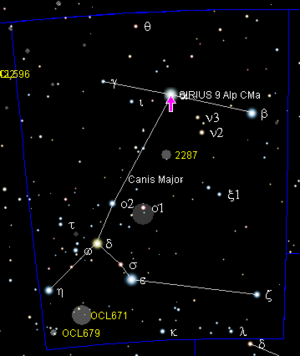Magnitude (astronomy) facts for kids

In astronomy, magnitude is a way to measure how bright an object looks. It helps us compare the brightness of stars, planets, and even man-made objects in space. The brighter an object is, the smaller its magnitude number will be. Sometimes, the brightest objects even have negative numbers!
For example, our Sun is super bright with a magnitude of -27. A full Moon is about -13, and the planet Venus can be as bright as -5. Even things made by humans, like Iridium flares, can be very bright at -9, and the International Space Station shines at -6.
Contents
How We Started Measuring Brightness
Long, long ago, around 150 BC, a Greek astronomer named Hipparchus came up with the first system to measure star brightness. He looked at the stars and gave the brightest ones a "magnitude" of 1. Then, he used bigger numbers for stars that looked dimmer. So, a star with a magnitude of 6 was much fainter than a star with a magnitude of 1.
About 300 years later, Ptolemy from Alexandria used Hipparchus's ideas to create a big book about stars. Much later, around 800 years after Ptolemy, a Persian astronomer named Al-Sufi added Arabic names to many of these stars. When European astronomers translated Al-Sufi's work into Latin, they kept many of these Arabic names. That's why many stars still have Arabic names today!
Different Ways to Measure Brightness
Astronomers use different types of magnitude to describe how bright objects are. Here are some of the main ones:
| Visible to typical human eye |
Apparent magnitude |
Brightness relative to Vega |
Number of stars brighter than apparent magnitude in the night sky |
|---|---|---|---|
| Yes | −1.0 | 250% | 1 |
| 0.0 | 100% | 4 | |
| 1.0 | 40% | 15 | |
| 2.0 | 16% | 48 | |
| 3.0 | 6.3% | 171 | |
| 4.0 | 2.5% | 513 | |
| 5.0 | 1.0% | 1 602 | |
| 6.0 | 0.40% | 4 800 | |
| 6.5 | 0.25% | 9 096 | |
| No | 7.0 | 0.16% | 14 000 |
| 8.0 | 0.063% | 42 000 | |
| 9.0 | 0.025% | 121 000 | |
| 10.0 | 0.010% | 340 000 |
- Apparent Magnitude: This is how bright a space object looks to us from Earth. It's like looking at a flashlight up close versus far away. The closer it is, the brighter it looks, even if it's not actually a super powerful flashlight. For example, Alpha Centauri looks brighter than Betelgeuse because it's much closer to Earth, even though Betelgeuse is a much bigger and brighter star in real life.
- Absolute Magnitude: This is a special way astronomers compare the true brightness of objects. Imagine if every star was placed at the same distance from Earth, exactly 32.6 light years away. Absolute magnitude tells us how bright each star would look at that exact distance. This helps astronomers compare how powerful stars really are, no matter how far away they are from us. When measured this way, our Sun has an absolute magnitude of 4.8, which is actually dimmer than Sirius!
- Visual Magnitude: This type of magnitude is all about what the human eye can see. It measures the brightness of a star based on how sensitive our eyes are to light.
- Photographic Magnitude: This is different from visual magnitude. Old cameras and film were more sensitive to blue light and other types of radiation that our eyes can't see. So, photographic magnitude measured how bright an object appeared on film, which could be different from how bright it looked to a person.
Related pages
See also
 In Spanish: Magnitud (astronomía) para niños
In Spanish: Magnitud (astronomía) para niños

